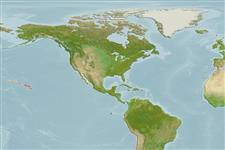Teleostei (teleosts) >
Pleuronectiformes (Flatfishes) >
Soleidae (Soles)
Etymology: Aseraggodes: Greek, aggos, -eos, -ous = vessel, uterus, carapace of a crab + Greek, aseros, -a, -on = to remove the appetite (Ref. 45335).
Eponymy: Therese Hayes was one of the collectors of the holotype (1991) at Midway Atoll, Hawaiian Islands. She has co-written various articles on Hawaiian fish, such as Annotated Checklist of the Fishes of Midway Atoll, Northwestern Hawaiian Islands (1993). (Ref. 128868), visit book page.
More on author: Randall.
Environment: milieu / climate zone / depth range / distribution range
Ecology
Marine; demersal; depth range 2 - 26 m (Ref. 13070). Tropical
Eastern Central Pacific: Hawaiian Islands.
Size / Weight / Age
Maturity: Lm ? range ? - ? cm
Max length : 6.6 cm SL male/unsexed; (Ref. 13070); 5.5 cm SL (female)
Short description
Identification keys | Morphology | Morphometrics
Anal soft rays: 54 - 61. Caudal peduncle absent. Dorsal- and anal-fin rays with a broad, membranous ridge extending from base of each ray and gradually narrowing to ray tip. Ocular side with prominent dark blotches in 3 rows; the middle one with just 2 blotches, the largest and darkest (Ref. 48239).
Benthic on sand, rubble or reef (Ref. 58302). Often buried in sand in caves. Feeds on small crustaceans (shrimps, crabs, isopods, ostracods, and amphipods, caprellids (Ref. 13070).
Life cycle and mating behavior
Maturity | Reproduction | Spawning | Eggs | Fecundity | Larvae
Randall, J.E., 1996. Two new soles of the genus Aseraggodes (Pleuronectiformes: Soleidae) from the Hawaiian Islands. Pac. Sci. 50(4):427-440. (Ref. 13070)
IUCN Red List Status (Ref. 130435: Version 2024-1)
Threat to humans
Harmless
Human uses
Tools
Special reports
Download XML
Internet sources
Estimates based on models
Preferred temperature (Ref.
123201): 24.9 - 25.6, mean 25.3 °C (based on 32 cells).
Phylogenetic diversity index (Ref.
82804): PD
50 = 0.5000 [Uniqueness, from 0.5 = low to 2.0 = high].
Bayesian length-weight: a=0.00977 (0.00466 - 0.02049), b=3.07 (2.90 - 3.24), in cm total length, based on LWR estimates for this (Sub)family-body shape (Ref.
93245).
Trophic level (Ref.
69278): 3.5 ±0.56 se; based on food items.
Resilience (Ref.
120179): High, minimum population doubling time less than 15 months (Preliminary K or Fecundity.).
Fishing Vulnerability (Ref.
59153): Low vulnerability (10 of 100).
